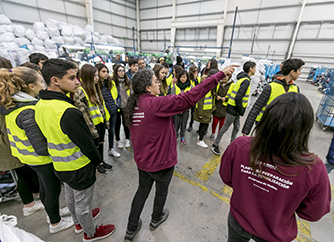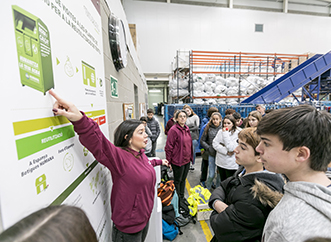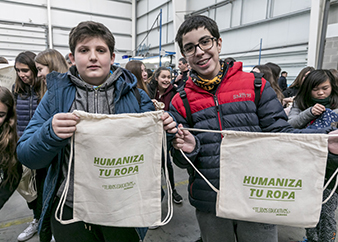consent_cookie
Duración: 1 year
Stores the user's cookie consent state
22-12-2017
As a complement to our awareness-raising work, we have a Visits to Plant Preparation for the Reuse of Textile Residues of Ametlla del Vallés, Leganés (Madrid) and Valderrubio (Granada), which is part of the 'Tejidos Educativos' Sensitization Program. The objective is to publicize our preparation work for the reuse of the used textile. Visits consist of planned routes that seek to convey the transparency of our actions and strengthen relationships with our collaborating entities.
"We did not know everything that is done with the clothes we give. We did not know what is behind our donations or the scope of the work you do, "confessed Marta Lloret, professor at the Institute of Vilablareix (Girona), after visiting our preparation plant for the reuse of Ametlla del Vallès (Barcelona). A hundred students from the center have participated in our Program of Visits, with which we want to open the doors of our equipment to society.
It is aimed at institutions, organizations and companies that have an interest in our work, with special attention to our public and private collaborators. Also to schools with anxiety to develop actions with their students in which the second life of the clothes are protagonists.
Humana's relationship with Vilablareix goes back to 2015: in this small municipality of Gerona, the selective collection of waste is done door to door. The textile fraction joined this system two years ago and, since then, neighbors and neighbors know that they can leave their clothing bag used on their portal on the first Monday of each month (it is added one more day in high season ).
Visit coordinated with the Institute and the City Council
Recently, from the institute they expressed their interest in knowing where the clothes they donated were going to stop, which led to a visit to our plant for preparation for reuse, coordinated with Vilablareix Town Hall. Divided into groups and accompanied by their tutors and members of the Visit Program, boys and girls of 12 and 13 years (around 100 in total) learned that donated clothing is managed by a team of professionals to ensure that the garments have the best possible destination to be reused according to their characteristics, quality and status.
"The clothes that I no longer use I put in a bag and my mother is the woman," acknowledged Josep, one of the students, during the tour. And he added, taking a look around: "Does that mean that I can find the ones that were my T-shirts and pants somewhere in this plant?". Well, if the donation has been recent, it is possible; If for some time, surely you have followed one of these four major destinations:
In the case of the educational centers, the visit is completed with the workshop "Hay Ropa Tendida" whose purpose is to spread the importance of the prevention of waste and the reuse of the used textile, its relation with the global sustainability, the protection of the environment and development cooperation. It also seeks to bring the environmental and social problems related to clothes to a family audience, as well as the benefits of acquiring prevention and reuse habits, and promoting their participation and collaboration.


